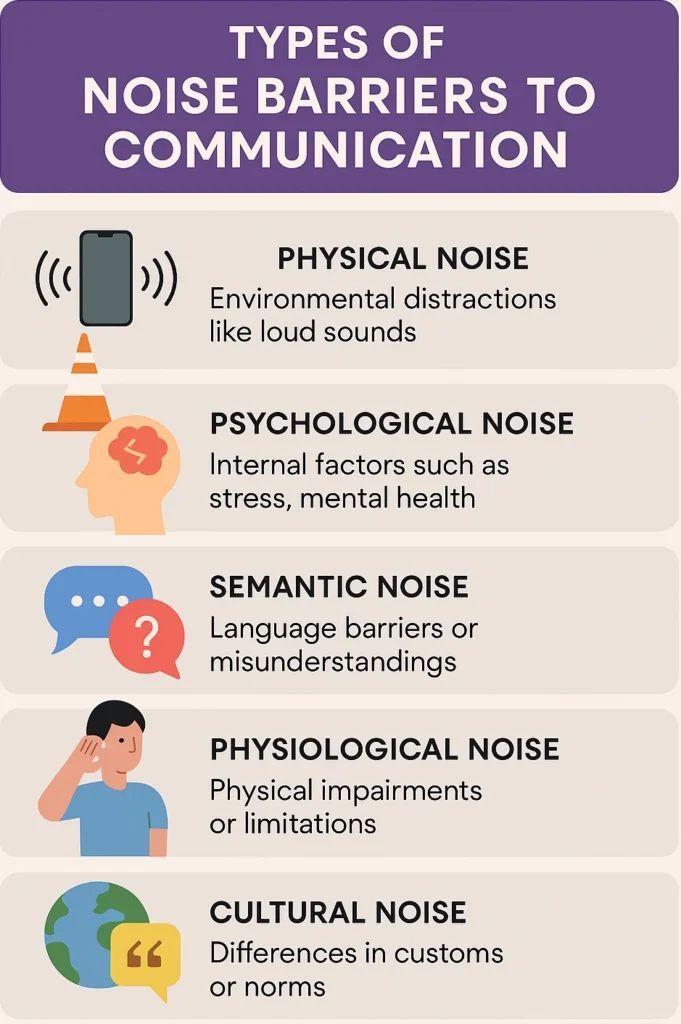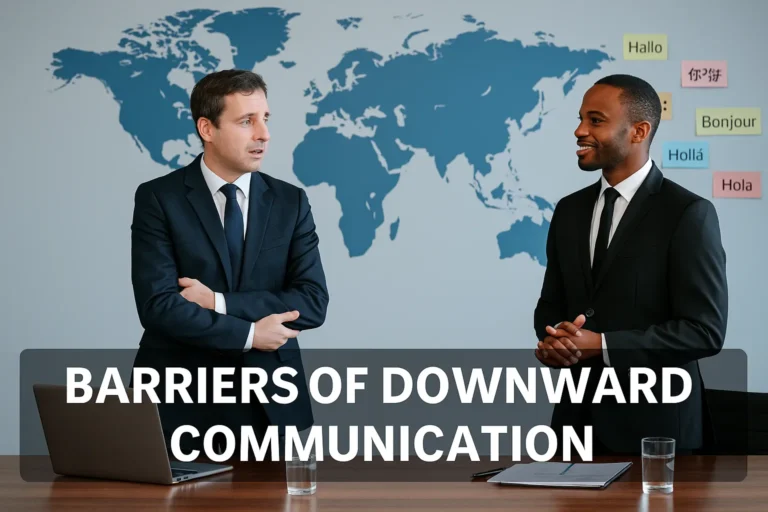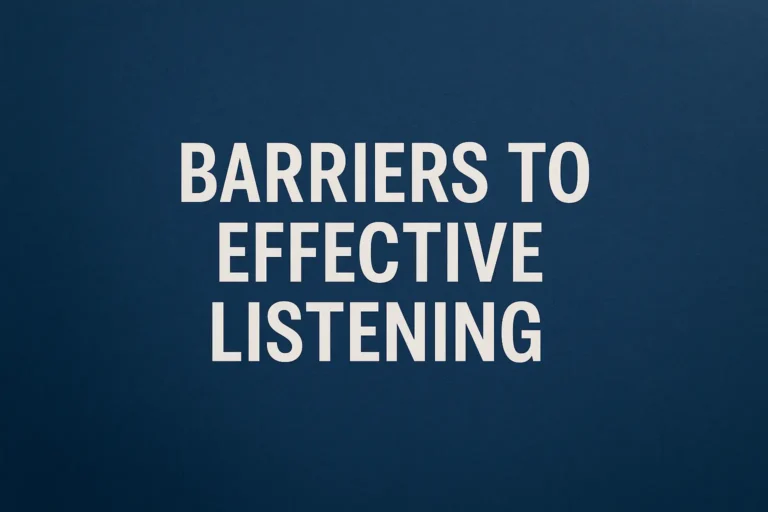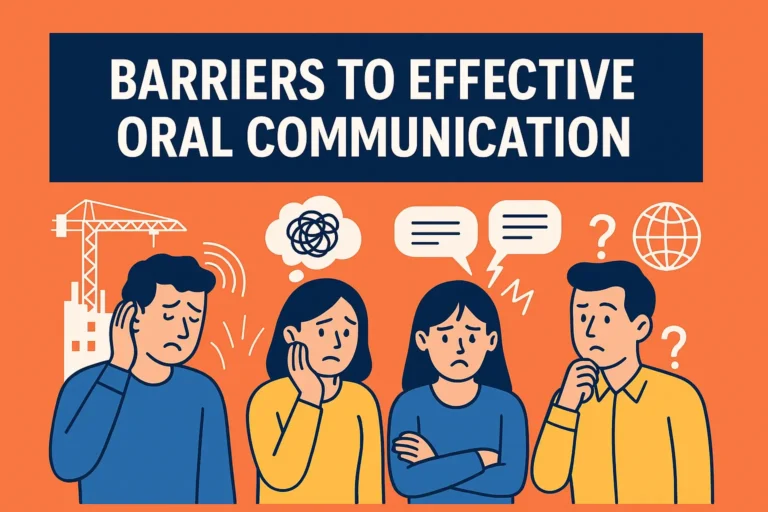Noise Barriers to Communication
Have you ever tried to share something important, only to realize the other person just didn’t get it? Chances are, you’ve experienced noise barriers to communication. These barriers pop up everywhere—from loud offices to emotional stress and technical issues on video calls. Whether you’re speaking face-to-face or using a digital platform, noise barriers to communication can block messages, causing confusion and misunderstandings. Learning to spot and remove these barriers helps every conversation flow better, at work and at home.
What Are Noise Barriers to Communication?
Noise is anything that disturbs the sending, receiving, or understanding of a message. It’s not only loud sounds. It’s also stress, jargon, weak Wi-Fi, cultural misreads, or two managers giving different instructions. In a world of constant pings and video calls, these barriers appear more than ever—and they cost teams time, money, and trust.
Different Types of Noise Barriers
Understanding the main types of noise barriers to communication can help you spot them before they ruin an important conversation.

Physical Noise
This is the easiest to spot. Physical noise includes any external sound or environmental factor that interferes with your message. Examples include:
- Loud conversations in the background
- Poor internet connection causing voice delays
- Traffic or construction sounds nearby
- Faulty microphones or speakers
In a busy office, employees might miss important details because of printers, ringing phones, or general chatter. At home, a barking dog or loud television can have the same effect.
Psychological Noise
Physiological noise barriers to communication relate to the body. Hearing loss, tiredness, illness, or hunger can all make it harder to process what someone is saying. These barriers are especially important to consider in schools, workplaces, and healthcare settings.
Semantic Noise
Semantic noise results from misunderstandings of words, phrases, or concepts. It occurs when the sender and receiver interpret language differently. Causes can include:
- Technical jargon
- Slang or regional expressions
- Ambiguous statements
- Language barriers between speakers
A doctor using medical terminology may confuse patients who don’t understand the vocabulary. Or, colleagues from different backgrounds may misinterpret each other’s words, even if they speak the same language.
Physiological Noise
Physical conditions can also block messages. This category covers hearing problems, illness, tiredness, or hunger. If someone has a cold or is exhausted, they might not catch every word during a conversation.
Channel and Technological Noise
Modern communication relies on technology, and with it comes a new kind of noise. Channel noise happens when the medium itself introduces interference. This might look like:
- Glitches in video calls
- Static on the phone line
- Echoes in conference calls
- Slow or dropped connections
Even a simple autocorrect mistake can create confusion, especially in written messages.
Cultural Noise
Culture shapes how people communicate. Differences in values, traditions, or nonverbal cues can lead to misunderstandings. A gesture or phrase considered polite in one culture may be rude in another. Cultural noise is especially common in global business and multicultural teams.
Causes of Noise Barriers
Noise barriers can pop up for many reasons. Here are the most common causes:
- Distractions in the environment: Noisy spaces or poor lighting
- Emotional state: Stress, anger, happiness, or sadness
- Health issues: Fatigue, hearing loss, illness
- Language and cultural differences: Accent, dialect, or unfamiliar customs
- Technology problems: Faulty equipment, poor signal, outdated software
- Bias and stereotypes: Preconceived ideas about a person or group
Knowing these causes helps people plan ahead and take steps to remove obstacles before they get in the way.
Real-World Examples of Noise Barriers
Let’s look at a few situations where noise barriers can create challenges:
Remote Work Meetings
Imagine a team on a Zoom call. Some members work from a noisy café, while others struggle with slow internet. During the meeting, one person uses industry jargon, while another faces distractions from kids at home. As a result, half the team misses key points and has to follow up later, slowing down the project.
Medical Appointment
A doctor explains a complex diagnosis to a patient using medical terms. The patient, anxious about their health and unfamiliar with the language, misunderstands the advice. Because of this, the patient misses an important step in their treatment plan.
School Classroom
A student who wears hearing aids finds it hard to keep up when classmates are talking and the teacher’s voice is soft. The noise barrier here is both physical and physiological. Unless addressed, it can affect the student’s learning.
Cross-Cultural Conversation
Two coworkers from different countries share feedback after a presentation. One uses gestures that are normal in their culture but confusing to the other. Misunderstandings occur, even though both are speaking English.
How Noise Barriers to Communication Affect Us
When noise barriers go unchecked, communication suffers in several ways:
- Messages may arrive incomplete or distorted
- Important details get lost
- Relationships face strain due to misunderstandings
- Work and learning slow down
- Team performance drops
A Deloitte study found that miscommunication leads to delays, errors, and lower productivity in organizations. By understanding how noise barriers operate, people can take action to keep communication clear and effective.
Strategies to Overcome Noise Barriers
You can’t remove every barrier, but you can lower their impact with a few practical habits.
Improve Listening Skills
Active listening means paying full attention to the speaker and avoiding distractions. Maintain eye contact, nod, or give short responses to show you’re engaged. If you don’t understand something, ask the speaker to repeat or explain in another way.
Use Clear, Simple Language
Stick to plain words whenever possible. Avoid jargon unless everyone knows it. When you must use technical terms, explain them briefly. Summarize important points at the end of a conversation or meeting.
Check Understanding
Encourage feedback. After sharing a message, ask others to repeat what they heard or if they have questions. This step helps spot misunderstandings before they cause problems.
Reduce Environmental Distractions
Find a quiet place for important conversations. If that’s not possible, use headphones, close doors, or mute background noise on calls. For online meetings, ask participants to keep microphones off when not speaking.
Address Emotional and Psychological Barriers
Stay aware of your mood and emotions. If you feel upset or stressed, it might be best to pause before having a crucial conversation. Encourage a calm, respectful environment where everyone feels safe to speak.
Mind Cultural Differences
Learn about different cultures, especially if you work in a diverse team. Be open-minded and patient if someone communicates differently. When unsure, ask politely for clarification.
Use Technology Wisely
Check your devices before meetings. Test microphones, cameras, and internet speed. In case of problems, let others know, and find other ways to connect, like phone calls or instant messages.
Repeat or Paraphrase Important Messages
Restating key points in different ways can help everyone understand, especially when technical issues or distractions arise. This habit also supports people with hearing or language challenges.
Tips for Reducing Noise Barriers
- Schedule important discussions for quiet times or places
- Keep meetings short and focused
- Summarize and confirm decisions before ending conversations
- Invest in good audio and video equipment
- Practice empathy—try to see things from the other person’s perspective
- Encourage everyone to ask questions and share concerns
Conclusion
Noise barriers to communication are common but not impossible to manage. With awareness and a few simple steps, you can keep these obstacles from blocking your message. Simple steps—like listening carefully, speaking clearly, checking understanding, and using technology wisely—can make a big difference. With these habits, your conversations will become smoother and more meaningful.
If you want to learn more about improving workplace conversations, check out our guide on overcoming barriers to communication. Remember, the path to better communication starts with a single, focused conversation.





